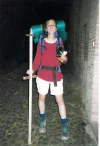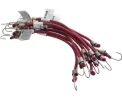There is a clear difference of opinion and two school s on this issue. My advice is simple (I think).
SINGLE STAFF
If you are inclined to use a single staff, get something locally to serve as an analog for it, to practice with. A broom stick is a possibility. Nothing fancy, just something to emulate the length, weight, and "feel" of a walking staff. According to my research, the "correct" length / height is from the ground to your shoulder, when the stick is plumb and perpendicular to the ground. But, do go with a length that suits you. In the end, you will have to carry that stick for a month. But you cannot take it to your bunk each night. You cannot bring it home as carry-on luggage. So, it will invariably end up in the daily growing pile of discarded walking staffs at the Pilgrim Office in Santiago.
Take a hike on varied terrain with this pole. Include fairly steep up and down hill climbs. If possible, wear a pack. I use plastic bags of crystal kitty litter in my bag to simulate a live load. Best sure to line your rucksack with a trash bag or two to avoid a potential mess. At present, I have one 15 and one 8-pound bags in my rucksack. With the rucksack, the total weight is 25 pounds (11.3 kg). While a tad higher than the 10 Kg recommended limit, for me, this is a good training weight.
The results will guide you...
HIKING POLES or STICKS ("Bastones" in Spanish)
As regards using "bastones" or walking poles there are as many uses for these poles as there are strong opinions in favor of them.
When correctly adjusted, your lower arms should be at right angles to your upper arms and parallel to the ground. These poles are infinitely variable as regards length. So this adjustment can easily be achieved. Here are some positive attributes to poles, and which a single staff cannot (mostly) replicate.
- Poles are better at helping you climb, especially on slippery trails. this increases safety and improves traction. Using two pioles is like having four-wheel drive (sort of)...
- Poles are better at breaking your descent from hills, especially on slippery trails. This prevents falls...remember four-wheel drive...
- Poles can significantly increase your walking speed on level ground, as they contribute to your forming a good walking pace.
- Poles, used correctly, transfer up to 25% of your rucksack weight to your arms and the poles, from your back.
- If you apply several bands of hi-viz reflective tape, like 3M safety tape, you can increase road-walking visibility by swinging a pole facing traffic. The oncoming driver sees a whirling glowing arc in low light conditions. Importantly, it gets attention! I use one band at the bottom and at each expansion section. Our colleague Magwood does this very well with lime green tape that matches her rucksack - oh so stylish!
- A pole can be sized and wedged into a window opening to provide hanging space for hand laundry to dry.
- If you camp, one or two poles are typically used to pitch an ultra-lightweight tent.
- Individual poles are better IMHO at poking at things along the trail...
- Individual poles, strapped to your right and left wrists are also good at pointing out directions or direction of motion. Your finger, or hand, just got at least a meter longer...
- You can use one or two poles as the mood suits you. You cannot do this with a single staff.
Others can, no doubt, add more good uses and attributes of walking poles; but these are mine.
Contrary, and politely, as regards the poster above, you will not likely have to repel brigands or louts on the Way. In a VERY rare situation, you may have to repel an aggressive dog. But in three Caminos, I have never encountered a nasty dog. They want to follow you, but are usually unimpressed otherwise. To them, seeing peregrinos is a daily, ho-hum, thing...
Others have remarked about various safety related aspects of walking poles. I endorse all of these and add that my pair of Leki Ultralight Poles saved my life (literally) in 2013. In late April, I was forced off the steep drop-off just before the summit of Alto de Perdon (the final 150 meters or so are treacherous). A pair of mountain bikers came hurtling DOWN TRAIL in the rain and wind. Visibility was poor and my poncho was cinched tight. My companion shouted "look out" at the last moment. My military training kicked in and I bailed off the trail to the right (it sure FELT like an ambush situation) while my companion bailed uphill to the left....duh! Anyway, to the right, there was NOTHING but air due to the steep drop-off, perhaps 10 - 15 meters at least to the pasture and scrub brush below.

My Leki pole bent, literally like an archery bow, to break my "final" fall. I later found out that the second cyclist managed to dump his bike and grab my rucksack harness just before I took a dive. That was the ONLY time I ever thanked a cyclist on the Camino, and the proximate reason for my dislike of sharing the trail...once burnt...twice shy. Ironically, I walked this section again in 2014, in a move to "get back on the horse..." To my surprise, there is now a cable mounted to vertical steel stanchions at the side of the trail to prevent this sort of things from happening again...go figure!
 WHAT KIND OF POLES DO I BUY?
WHAT KIND OF POLES DO I BUY?
As regards what kind of walking poles to buy, the first "fork in the road" is the strongly held preference (by some) between conventional walking poles and "Pacer Poles." Pacer Poles are a specific type of hiking stick that is engineered primarily to aid level ground performance. I do not have direct experience with these poles. I recommend you use the Forum search engine to query "Pacer Poles."
Once you made the decision to go with sectional walking poles or bastones, there are several considerations. All of these issues are discussed elsewhere in this Forum. But I will highlight the considerations:
- Aluminum alloy or carbon fiber - a cost and weight issue. Carbon fiber is much lighter, but perhaps twice the cost.
- Twist cam adjustment or flip adjustment - original designs use the easily serviced twist to tighten or loosen system. More recent styles use a flip up or down lever to apply pressure on pole sections.
- Uni-fit or left-right - most better brands have handgrips molded to left and right hands to improve grip and comfort.
- Wrist straps - tether the pole to your hand. They should be adjustable.
- Rubber tips - PLEASE do buy and use rubber tips on all metal poles. This eliminates the "click-clack" noise that, while ubiquitous to the Camino, we love to hate, especially when you desire quiet time. I is especially noticeable early in the morning in small villages. It wakes the locals too. So please be considerate to all. The rubber tips are a LOT cheaper in Europe and can be bought or replaced almost anywhere. Expect a pair to last for at least a month of daily use, unless you lose one (or more) in the mud. I always carry spares. I give them to others just to shut their poles up. The diameter of most poles is fairly standard, across the industry.
HOW DO I TRANSPORT MY POLES?
Assume that NO POLES can be brought onto an airplane. This Forum contains many anecdotal stories of folks who claim to bring their poles on-board "all the time." Be wary. The permission is likely location and airport security-official-specific. I would not want to leave it to chance.
I always shorten my poles all the way and snug them closed, strap them to the outside of my rucksack using side pockets and available straps or cords. I then put my rucksack in a bright-colored, cheap, laundry bag purchased from the local dollar sore (pound shop). I actually purchased one for a single USD last year. The laundry sack doubles as a rucksack liner, laundry bag, and return shipping bag. Just double-tie the pull-sting and affix one or more luggage ties WITH YOUR INITIAL DESTINATION (e.g. Hotel Ramunctho, Saint Jean, Pied de Port, France). I recommend attaching one o the rucksack in the laundry bag, and another to the outside of the sack, attached to the tie-string. This way, if temporarily misplaced, the airline will
deliver the bag to your starting point, instead of your permanent home...

I hope this helps.
























